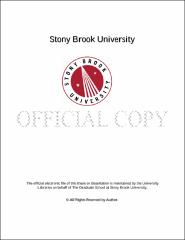| dc.identifier.uri | http://hdl.handle.net/1951/60241 | |
| dc.identifier.uri | http://hdl.handle.net/11401/70912 | |
| dc.description.sponsorship | This work is sponsored by the Stony Brook University Graduate School in compliance with the requirements for completion of degree. | en_US |
| dc.format | Monograph | |
| dc.format.medium | Electronic Resource | en_US |
| dc.language.iso | en_US | |
| dc.publisher | The Graduate School, Stony Brook University: Stony Brook, NY. | |
| dc.type | Dissertation | |
| dcterms.abstract | Electroplated hard chrome (EHC) is used for wear and corrosion resistance applications in many industries. The hexavalent chrome present in the plating baths is a major concern due to its highly carcinogenic behavior. . In addition, EHC has technological problems including micro and macro cracking, inconsistent corrosion protection, long processing time and wide differences in behavior of coatings deposited by different plating houses. Thermally sprayed (TS) cermet coatings with a hard ceramic (e.g. tungsten carbide (WC)) embedded in a ductile matrix (Co, Cr and/or Ni) are being developed as candidates for chrome replacement. Thermal spray techniques, specifically high velocity oxy-fuel (HVOF), provide an environmental friendly method for coating surfaces and are increasingly used for wear, friction and corrosion protection. However, to validate the TS cermets, the issue of interconnected porosity, usually a marked characteristic of TS coatings, needs to be addressed. In this study, the influence of processing parameters on the corrosion performance of HVOF-deposited metallic and cermet coatings has been determined. Electrochemical studies including open circuit potential and cyclic polarization were performed to assess corrosion susceptibility and passivation behavior. The results indicate a strong correlation of processing parameters, in situ particle state and mechanical properties with corrosion behavior. | |
| dcterms.available | 2013-05-24T16:38:17Z | |
| dcterms.available | 2015-04-24T14:45:05Z | |
| dcterms.contributor | Weyant, Christopher M | en_US |
| dcterms.contributor | Welch, David | en_US |
| dcterms.contributor | Fortmann, Charles M | en_US |
| dcterms.contributor | Korach, Chad S. | en_US |
| dcterms.creator | Dey, Ravi | |
| dcterms.dateAccepted | 2013-05-24T16:38:17Z | |
| dcterms.dateAccepted | 2015-04-24T14:45:05Z | |
| dcterms.dateSubmitted | 2013-05-24T16:38:17Z | |
| dcterms.dateSubmitted | 2015-04-24T14:45:05Z | |
| dcterms.description | Department of Materials Science and Engineering | en_US |
| dcterms.extent | 178 pg. | en_US |
| dcterms.format | Application/PDF | en_US |
| dcterms.format | Monograph | |
| dcterms.identifier | http://hdl.handle.net/1951/60241 | |
| dcterms.identifier | http://hdl.handle.net/11401/70912 | |
| dcterms.issued | 2012-08-01 | |
| dcterms.language | en_US | |
| dcterms.provenance | Made available in DSpace on 2013-05-24T16:38:17Z (GMT). No. of bitstreams: 1
StonyBrookUniversityETDPageEmbargo_20130517082608_116839.pdf: 41286 bytes, checksum: 425a156df10bbe213bfdf4d175026e82 (MD5)
Previous issue date: 1 | en |
| dcterms.provenance | Made available in DSpace on 2015-04-24T14:45:05Z (GMT). No. of bitstreams: 3
StonyBrookUniversityETDPageEmbargo_20130517082608_116839.pdf.jpg: 1934 bytes, checksum: c116f0e1e7be19420106a88253e31f2e (MD5)
StonyBrookUniversityETDPageEmbargo_20130517082608_116839.pdf.txt: 336 bytes, checksum: 84c0f8f99f2b4ae66b3cc3ade09ad2e9 (MD5)
StonyBrookUniversityETDPageEmbargo_20130517082608_116839.pdf: 41286 bytes, checksum: 425a156df10bbe213bfdf4d175026e82 (MD5)
Previous issue date: 1 | en |
| dcterms.publisher | The Graduate School, Stony Brook University: Stony Brook, NY. | |
| dcterms.subject | Corrosion, Electrochemical, Hexavalent, Porosity, Thermal Spray | |
| dcterms.subject | Materials Science | |
| dcterms.title | Corrosion Studies on Thermally Sprayed Materials for Hexavalent Chromium Replacement | |
| dcterms.type | Dissertation | |

